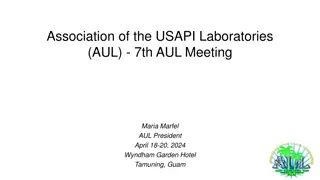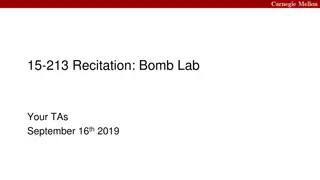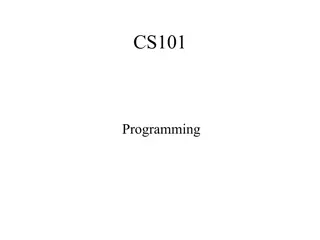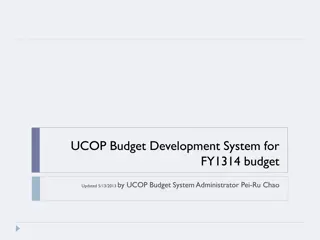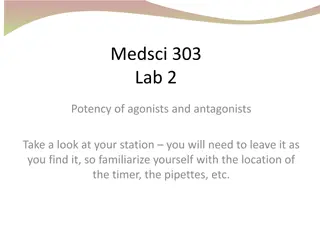Logon Instructions for FMHS Lab Access
Please log on to the FMHS lab system using the provided login details. Ensure to follow the guidelines and rules for lab attendance and required items. Access course manuals, website links, and staff contact information. Stay updated on evaluation criteria and group assignment requirements.
Download Presentation

Please find below an Image/Link to download the presentation.
The content on the website is provided AS IS for your information and personal use only. It may not be sold, licensed, or shared on other websites without obtaining consent from the author.If you encounter any issues during the download, it is possible that the publisher has removed the file from their server.
You are allowed to download the files provided on this website for personal or commercial use, subject to the condition that they are used lawfully. All files are the property of their respective owners.
The content on the website is provided AS IS for your information and personal use only. It may not be sold, licensed, or shared on other websites without obtaining consent from the author.
E N D
Presentation Transcript
Turn your Computers on Please Logon using the details below: Login: FMHS\phcol303 Pswd: Pharma14 (also written on the white boards around the room) Launch NetLogin using your UPI and pswd *before* launching Explorer (or other browser) to have Internet access
Course Manuals do you have one? Tutors & Technicians Pharmacology/Pharmacy Teaching Lab space for all labs and tutorials Lab Streams only switch with permission! Attendance is compulsory! - Sign in or you are considered absent
Things to bring to labs lab coats, CLOSED foot shoes, calculator, manual, $2 coin - NO bags, no jackets, no food, no drink bottles Mobile phone policy turned off and/or in the locker or we confiscate it Lockers -$2 coin is refunded, do not leave lockers unlocked Health & Safety -Signing in next week is your acknowledgment that you read and understood this section on the website.
Cecil & 303 Website Log onto Cecil Can you see the Course website when you select Current Courses> MEDSCI.303FH Course website link in Knowledge Map (or flexiblelearning.auckland.ac.nz/medsci303/index.html) Piazza Did you receive a welcome email to your AucklandUni email? Please log on and complete the polls if you have not done so yet
Contacting Staff Office Hours: (contact details on website and on p.3) Liam Mon 1-2.30pm, Fri 12-1.30pm?? TBD Leslie by appointment Wed 2-3pm, Thu 9-10am De Email - medsci303contact@auckland.ac.nz Please identify yourself by name and ID! Phone identify yourself by name and course Discussion Forum Piazza discussion forum, you will receive an email invitation today, if not contact a Tutor
Student Evaluation 2013 Go to Lab 1: Introduction page of website Open the pdf Take a few minutes to read it
Student Evaluation 2013 Requirements for the group assignment were clearly explained. 65.7% Agreed + Strongly Agreed vs. 17.8% Disagreed + Strongly Disagreed. I was clearly informed how my learning would be assessed 72.8% Agreed + Strongly Agreed vs. 10.1% Disagreed + Strongly Disagreed. The volume of work in this course was fair and reasonable. 64.5% Agreed + Strongly Agreed vs. 14.8% Disagreed + Strongly Disagreed I received helpful feedback on my learning progress. 62.1% Agreed + Strongly Agreed vs. 14.2% Disagreed + Strongly Disagreed
Student Evaluation 2013 What was most helpful to your learning? Provision of Lecture Recordings Staff Practicals/Laboratories Resources provided on the course website were helpful
Student Evaluation 2013 What improvement would you like to see? Consistency of marking in the report assessment Report Writing Tutorial content Peer assessment component of the report grade was unclear
Expectations of Students Receptiveness things we do aren t just for fun, designed to improve Pharmacology knowledge and multidisciplinary skills Constructive approach to your learning Coming to labs prepared Communications with tutors Why? Reflective practice Academic Integrity
Expectations of Tutors Courteous and receptive to the needs of students Fun? Facilitation of your learning Cecil resources and announcements Piazza Discussion Forum link through Cecil Medsci 303 website link through Cecil Useful feedback on assessments please come talk to us if a comment is not clear
Animals / Animal Tissue? Animals and Animal Tissue are used in our course Objections discuss with Tutors Live animals only? Alternatives are available. All animal work? Reassess whether this course is for you. Full and rigorous approval has been attained from the University Ethics Committee for all aspects of the course
Assessment Format Mid-semester test (10%) Individual Lecturers Final Exam (50%) Labs (40%) Group Lab Reports x3 (17%) Tutors MCQ in-lab tests x4 (8%) Animal Handling Test , MCQs (2.5%) Lab Test lecture slot, last week (12.5%)
Lab Reports Refer to the Writing Lab Reports section of the website Thorough Report-Writing Guides will be provided for each report (decreasing detail as semester progresses) {These two are the main sources of information. Some details will be conveyed in the lab next week} Consult Piazza If in doubt, ask! Group assessment
Cooperative Learning NEXT WEEK - You will either be randomly assigned to a groups of 3 or will be allowed to self select a group. These will be the people you will conduct experiments with each week All lab reports will be submitted as a group The mark achieved for the report will be allocated to all the members of the group (scaled on participation) Peer Evaluation Process
Peer Evaluation Refer to the Groupwork page on the course website Peer evaluation to be submitted for each lab report Will scale each individual s mark Anonymous Submitted online Individuals will get mark via Cecil, no mark on report
Cooperative Learning Grades Your participation will determine whether you are awarded the full mark for your report. Report out of 100 Peer review out of 32 (8 categories marked 0-4) 50% of your report mark is fixed and 50% is scaled (50- 100%) based on your PE mark i.e. You get a proportion of your mark depending on how you contributed. 32/32 (100%) PE 75% 0% 100% 50% (fixed) 16/32 (50%) PE
Cooperative Learning Grades Your mark scaled (50-100%) i.e. You get a proportion of your mark depending on how you contributed. e.g. Report gets 70% 100% PE = 70 marks 0% 50% fixed (35 marks) 100% (70 marks) (0 marks) 50% PE = 52.5 marks
Report mark PE (/32) 100 70 Student 1 25 62 89 Student 2 25 62 89 Student 3 22.67 60 85 Report mark PE (/32) 100 70 Student 1 31.67 70 99 Student 2 30.33 68 97 Student 3 22.33 59 85
Benefits of Cooperative Learning More closely related to future work environments. Better engagement with the material so you can contribute. More conducive environment to ask questions in. Teaching is the best way of learning
Potential Problems Students with a better understanding will do all the work and others will get the marks too. Group members don t get on. Don t feel like you can mark someone down (friend?) Someone in the group needs to attend another lab stream. Someone misses the lab altogether (illness, etc)
Excel Skills Constructing figures Appropriate style (bar, line, pie chart...) Axis position and numbering Legends Fitting curves linear vs. non-linear regression Error bars (SD)
Excel Exercise On MEDSCI303 course website: Use left-hand side navigation Go to Lab 1: Introduction Pre-lab: Excel Practical Find Serotonin practice sheet AND Constructing Concentration-Response Curves in Excel NOTE: Link to Student Excel Courses run by CAD!
Excel Figure 120 100 Contractile response (% max) 80 60 40 20 0 -9 -8 -7 -6 -5 -4 -3 -2 -1 0 Log [5-HT] (M) Figure 1: Contraction of guinea pig ileum in response to serotonin (5-HT). Tissue was stimulated at five minute intervals with increasing concentrations of 5-HT. Estimated pD2 is 6.2. The data are expressed as percentages of maximum response and data points represent mean +/- SD, n=4.
Prism Figure 100 C o n tractile R esp o n se (% ) 80 60 40 20 0 -8 -7 -6 -5 -4 -3 -2 L o g [5-H T ] (M ) F ig u re 1 : C o n tra ctio n o f g u in e a p ig ile u m in re sp o n se to S e ro to n in (5 -H T ). T h e d a ta a re e xp re sse d a s th e p e rce n ta g e o f th e m a xim a l re sp o n s e in d u ce d b y 5 -H T . T h e d a ta in cre a se s e xp o n e n tia lly w ith o u t re a ch in g a p la te a u . p D2 = 6 .9 . D a ta p o in ts re p re s e n t m e a n + /- S D , n = 4 .
Prism Figure Figure 1: Contraction of guinea pig ileum in response to Serotonin (5-HT). The data are expressed as the percentage of the maximal response induced by 5-HT. The data increases exponentially without reaching a plateau. pD2 = 5.9. Data points represent mean +/- SD, n= 4.
Go to page 5 of your manual Date Mar 3/4 Mar 10/11 Mar 17/18 Mar 24/25 Mar 31/Apr 2 One Compartment model multiple doses Mid-Semester/Easter Break (Fri 3 April Sat 18 April) Apr 21/22 Lab Report Tutorial Apr 28/29 Introduction to Animals May 5/6 Routes of Drug Administration May 12/13 Induction/inhibition in vivo May 19/20 Induction/inhibition in vitro May 26/27 PK problems June 2/3 No Labs Topic Assessment Hand-in Date Laboratory safety & introduction to labs Potency of Agonist & Antagonist Effects of pH on Absorption One Compartment model single dose Report 1 In-lab MCQ In-lab MCQ Report 2 In-lab MCQ Report 3 In-lab MCQ In-lab MCQ
Assessment Dates Report 1 Due 12am (midnight) SUNDAY March 22nd Report 2 Due 12am (midnight) SUNDAY Apr 26th Report 3 Due 12am (midnight) SUNDAY May 17th Hand in via Turnitin only! Details will be provided prior to submission deadlines.
Vote for how groups are made https://piazza.com/class/i4xblyog9ap5oh?cid=7 Piazza, @7 Voting closes 12pm (midday) Friday.
Penalties All laboratories must be completed to a satisfactory standard, which includes, but is not limited to, participation and submission of results to a class data sheet. Failure to complete laboratories to a satisfactory standard will result in a penalty of up to -4.5% per affected laboratory (that means 4.5% out of 40% for the labs makes it hard to pass the practical component!) Laboratory reports submitted after the deadline will lose 10% of the marks allocated to that report per 24 hour period or part thereof late (i.e. up to 24h late = -10%, up to 48h late = -20% etc).
Lab Test lecture slot 45 mins, 25 marks, 12.5% 17-25 short answer questions All questions based on learning objectives or class data from non-report labs Example questions have been posted on Cecil Preference for time? Piazza @8
Student Reps Give student feedback where necessary to course coordinator Help out your fellow classmates Add a little extra something to your CV Little work attend 2 meetings of class reps in the semester Organise a class party? (No longer funded )
S.A.M.S Student Association for the Medical Sciences See pdf file on Cecil or on Medsci 303 website homepage.
Intro to Organ Baths Designed for studying isolated tissue - a pharmacology screening tool to determine the concentration-response relationship in a contractile tissue Keep tissue alive by providing 1. Nutrients in the Krebs solution 2. Carbogen gas (95% O2 / 5% CO2) (keep an eye on these bubbles during the lab) 3. Warmth via heated Krebs solution
Intro to the Organ Bath The Bath Krebs Organ Bath Tap to Drain and Refill Everyone drain and refill your bath one time now!
Intro to the Organ Bath Surrounding Apparatus B) Do Not Touch! C) Unhook from force transducer to suspend tissue A) Adjust resting tension D) Loosen to remove carbogen hook Tissue hooks
Organ Bath Processes Put hooks back in (will have tissue attached for you next week) See bubbles? Approx 2/sec? Try adjusting carbogen flow (gently!) Tip beaker of water in to reservoir Practice emptying and refilling organ bath using tap
BEFORE LEAVING: Leave organ bath overflowing (will drain reservoir) Close programs - do NOT save changes and do NOT save files onto the desktop Log off computers Push stools under benches Tidy away mouse, keyboard etc.





